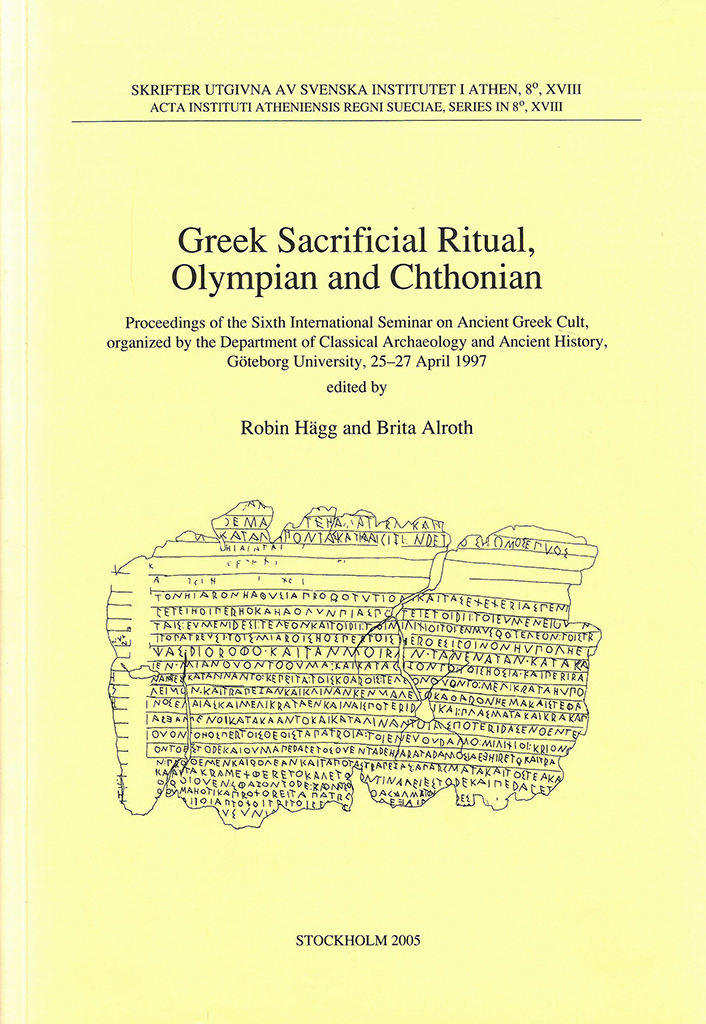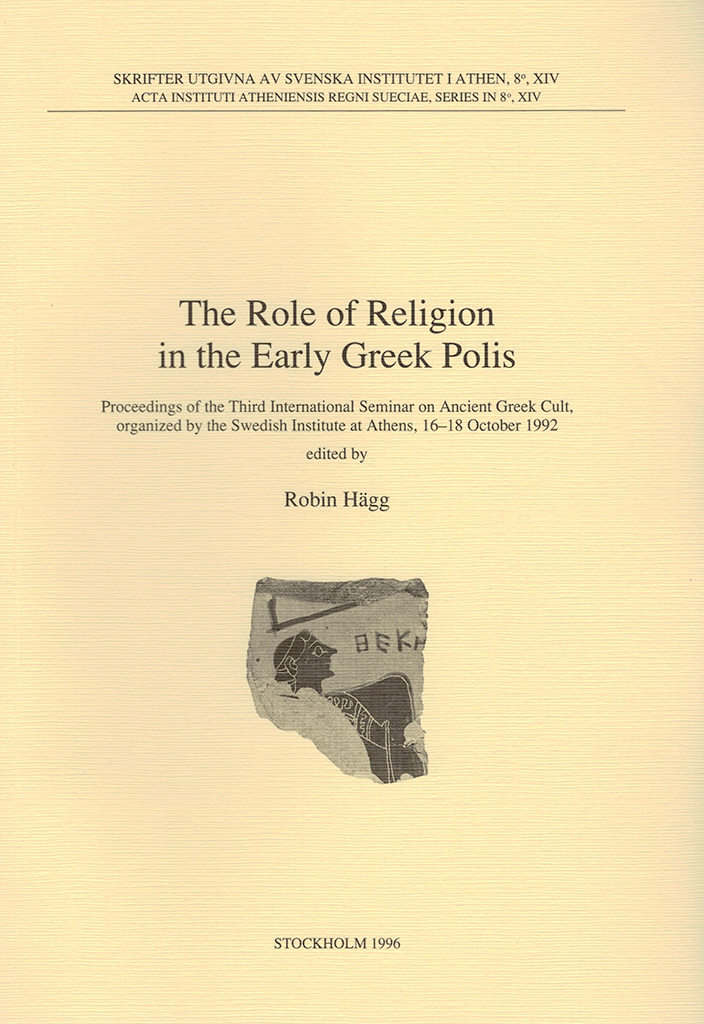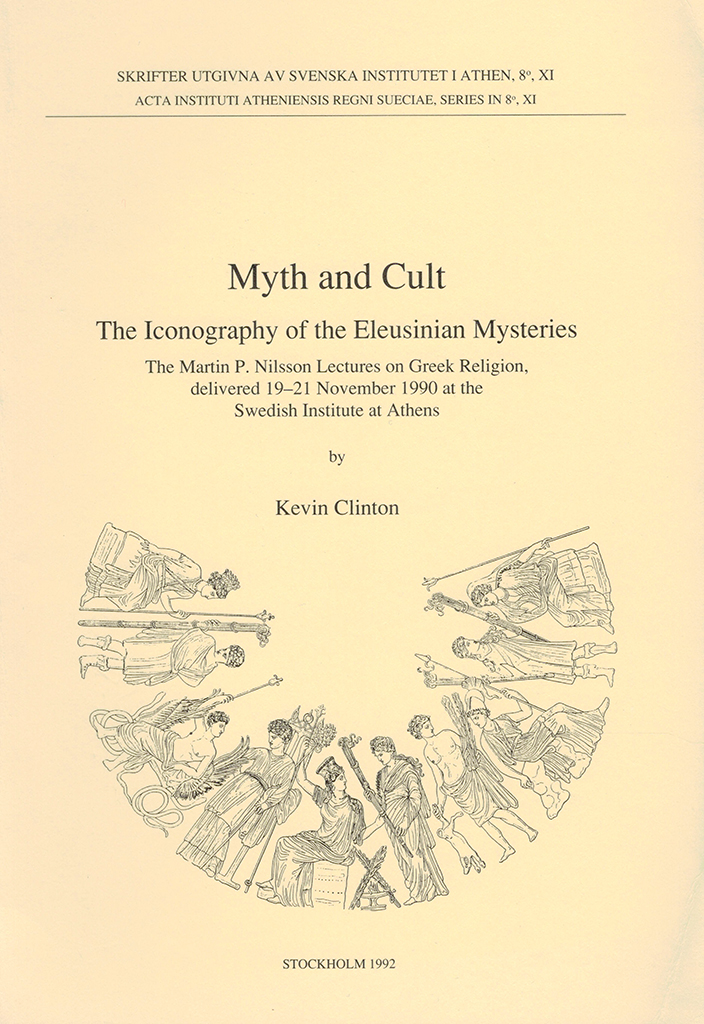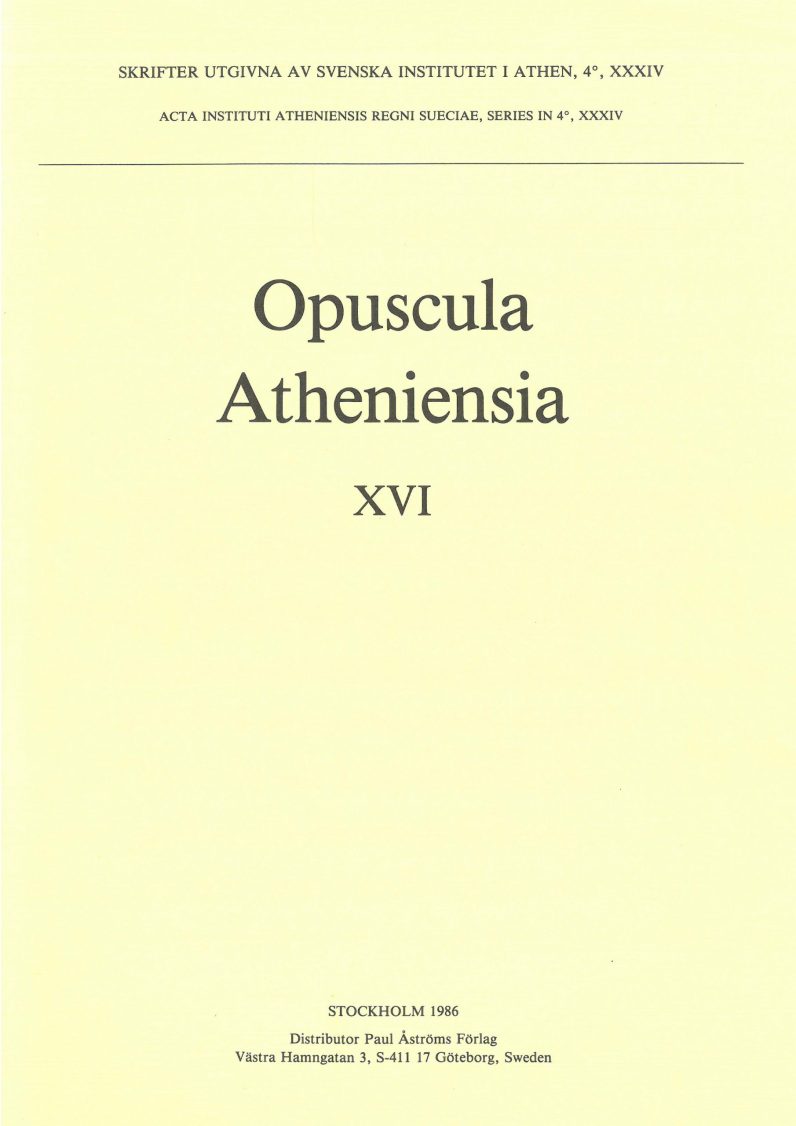Distributed by Astrom Editions. Greek sacrificial ritual, Olympian and Chthonian. Proceedings of the Sixth International Seminar on Ancient Greek Cult, organized by the Department of Classical Archaeology and Ancient History, Göteborg University, 25–27 April 1997 Edited by Robin Hägg & Brita Alroth A collection of eighteen papers, read or circulated at an international seminar in Göteborg, that deal with the ancient Greek sacrificial ritual, with special reference to the traditional dichotomy between the Olympian and the chthonian aspect, the relevance of which has been questioned in modern research. Among the special topics discussed are sacrifices to heroes and in the cult of the dead, magical sacrifice, sacrifice to the sea, pig sacrifice and the sacrifice of pregnant animals. Other aspects dealt with include the role of dedications in the cult and the practicalities of ruler-cult, as well as the priest’s role in Greek sacrifice. Several contributions discuss the implications of the recently published lex sacra from Selinous for the understanding of Greek sacrificial practice, reinterpreting previously known inscriptions in the light of the new evidence. Two papers deal with descriptions of sacrifice in Greek tragedy (Aeschylus, Oresteia; Sophocles, Trachiniae). There is a bibliographical survey of faunal remains from Greek sanctuaries…
Distributed by Astrom Editions. See record at WorldCat: http://www.worldcat.org/oclc/849019970. The role of religion in the early Greek polis. Proceedings of the Third International Seminar on Ancient Greek Cult, organized by the Swedish Institute at Athens, 16–18 October 1992 Edited by Robin Hägg These twelve papers read at an international seminar in Athens deal with various aspects of the role of religion in the early Greek polis, based on the epigraphical, iconographical and archaeological evidence. Among the special topics discussed are territorial myths and the mythical articulations with regard to the early polis, the Greek temple-builders, the distribution of offerings and rituals between graves and sanctuaries, the development of sacred and profane civic ideology in Athens, processions (pompai), verbal and ritual obscenity in women’s cults, prohibitionary inscriptions, the role of the seer, the Thesmophorion in central Athens, the cults in Solonian Athens, cults by the seashore and Dionysos at Argos. Contents Preface (p. 7) Irad Malkin | The polis between myths of land and territory (pp. 9–19) Walter Burkert | Greek temple builders: who, where and why? (pp. 21–29) François de Polignac | Entre les dieux et les morts. Statut individual et rites collectifs dans la cite archaïque (pp. 31–40) Sanne…
Distributed by Astrom Editions. See record at WorldCat. Myth and cult. The iconography of the Eleusinian Mysteries. The Martin P. Nilsson Lectures on Greek Religion, delivered 19–21 November 1990 at the Swedish Institute at Athens By Kevin Clinton Iconography serves as the starting part for the treatment of central aspects of the myth and cult of the Eleusinian Mysteries. The presence of the Mirthless Rock in artistic presentations, its location in the sanctuary, and its relation to the Callichoron Well provide a perspective for assessing the aetiological elements in the Homeric Hymn to Demeter and the relation of the Hymn to Eleusis. The Iconography of Eubouleus, Iakchos, and Eumolpos is established, and that of Triptolemos and Ploutos is discussed extensively. The importance of Eubouleus in artistic representations is seen to correspond to his importance in the Mysteries, and the identification of him in certain scenes reveals his function in the myth of the Mysteries. Discussion of his role in the Thesmophoria leads to an examination of the relation of the Mysteries to the Thesmophoria. The various roles of all these figures in artistic representations provide a basis for revised interpretations of several works of art, and these interpretations are exploited…
Published by the Swedish Institute at Athens. Distributed by Astrom Editions. Opuscula Atheniensia 16 Ed. Brita Alroth Contents Paul Åström, ‘Hala Sultan Tekke—An international harbour town of the Late Cypriot Bronze Age’, pp. 7–17. Paul Åström & Katie Demakopoulou, ‘New excavations in the Citadel of Midea, 1983–1984’, pp. 19–25. Paul Åström, R. Maddin, J.D. Muhly & T. Stech, ‘Iron artifacts from Swedish excavations in Cyprus’, pp. 27–41. Kevin Clinton, ‘The author of the Homeric Hymn to Demeter’, pp. 43–49. Harold D. Evjen, ‘Competitive athletics in ancient Greece: the search for origins and influences’, pp. 51–56. Nanno Marinatos & Robin Hägg, ‘On the ceremonial function of the Minoan polythyron’, pp. 57–73. Erik Østby, ‘The archaic temple of Athena Alea at Tegea’, pp. 75–102. Eva Rystedt, ‘The foot-race and other athletic contests in the Mycenaean world. The evidence of the pictorial vases’, pp. 103–116. Charlotte Scheffer, ‘Some further comments on the gorgoneion skyphoi’, pp. 117–122. Miscellanea Yvonne Backe-Forsberg & Christina Risberg, ‘Metal working at Asine. ‘New’ finds from the 1926 season’, pp. 123–125. Robert B. Koehl, ‘Another look at the Mycenaean Base Ring vase from the Athenian Agora’, pp. 125–126. David Symons, ‘An unpublished tomb group from Paphos’, pp. 127–130. Robin Hägg,…




